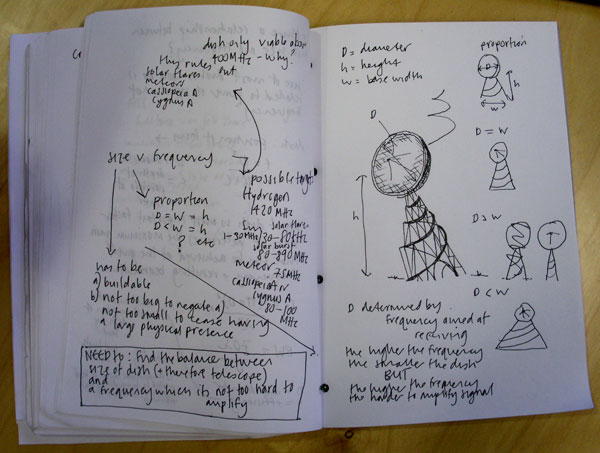September 28, 2004
H

As far as I understand it there's a balance between the size, the diameter, of a radio dish, and the frequencies it will pick up.
The higher frequencies are, the more difficult they are to amplify, so in the design of my telescope there is a trade off between building it not too large, not too small, yet not over complicating the task of amplifying the signal.
Furthermore there is no point just building it to pick up a convenient frequency. It needs to be aiming for a band in which something is going to be picked up. What this all means is that I need to find an interesting frequency that can be amplified without too much trouble, yet won't require an overly large dish.
Once this is sorted out the rest of the dimensions, the height and width of the tower, will be easy to work out. Then it's just a question of deciding on proportions, whether the diameter of the dish should be greater, equal or less than the width of the base of the tower, and by how much.
I need to confirm this but I read in some old notes that the diameter of the dish has to be approximately twice the wavelength. Thus a 5.2 meter diameter dish would pick up signals in the region of 2.6 meters wavelength, which in turn is a frequency of around 1420 Mhz*, the frequency of emissions of neutral hydrogen.
"after being excited, a neutral hydrogen atom will spontaneously decay, on average taking about 12 million years, and emit a photon with a frequency of 1420 Mhz". A long time to wait, but as there's so many there's always a potential dish full emitting a photon at any instant (if you point the dish in the right place).
What's the big deal about hydrogen ? As far as I can understand it hydrogen clouds represent the beginnings of structure in the universe - the point at which lone protons attract an electron in the particle soup of the early universe. Thus mapping clouds of hydrogen is akin to mapping the Cosmic Microwave Background, but later on in time. A billion years as opposed to three hundred thousand. Mapping concentrations of hydrogen, one sees where the density fluctuations are in the universe, the folds and wrinkles out of which emerged large scale structure.
*This is wrong. According to my calculations, the wavelength of 1420 Mhz is around 20 centimeters. So why would a 5.2 meter dish be used to detect hydrogen ? Certainly not because of the diameter = twice the wavelength theory. Don't know where I got this information from. If anyone understands the relationship between dish diameter and frequency I'd love to know !
Some clarification . . . don't know where this thing about the diameter being twice the wavelength comes from. Maybe this is a minimum (though I doubt it), certainly not a maximum.
The way I understand it now is that the bigger the dish the better, the more it can receive, the more sensitive it is. ie it can recieve fainter and fainter sources, the larger it is.
Size is also related to resolution, how well the telescope can resolve between objects close to each other. Wavelength / distance = angular resolution. As distance (diameter of dish or distance between 2 seperated telescopes*) increases angular resolution gets smaller (which in this case is good - the smaller the resolution the better).
*Interferometry, using two or more telescopes in tandem at differet locations, increases resolution (but not sensitivity).
The wavelength of 1420 MHz is 21 centimeters, hence the fact that it's also referred to as the 21 cm line.
So the dish needs to be at least 21cm accross, or 42 cm if the double wavelength thing is correct . . . but the bigger it can be the better.
Posted by: Jem Finer at October 25, 2004 5:54 PM